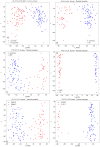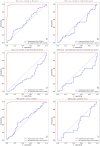Infrared Spectroscopy of Urine for the Non-Invasive Detection of Endometrial Cancer
- PMID: 36291799
- PMCID: PMC9600188
- DOI: 10.3390/cancers14205015
Infrared Spectroscopy of Urine for the Non-Invasive Detection of Endometrial Cancer
Abstract
Current triage for women with post-menopausal bleeding (PMB) to diagnose endometrial cancer rely on specialist referral for intimate tests to sequentially image, visualise and sample the endometrium. A point-of-care non-invasive triage tool with an instant readout could provide immediate reassurance for low-risk symptomatic women, whilst fast-tracking high-risk women for urgent intrauterine investigations. This study assessed the potential for infrared (IR) spectroscopy and attenuated total reflection (ATR) technology coupled with chemometric analysis of the resulting spectra for endometrial cancer detection in urine samples. Standardised urine collection and processing protocols were developed to ensure spectroscopic differences between cases and controls reflected cancer status. Urine spectroscopy distinguished endometrial cancer (n = 109) from benign gynaecological conditions (n = 110) with a sensitivity of 98% and specificity of 97%. If confirmed in subsequent low prevalence studies embedded in PMB clinics, this novel endometrial cancer detection tool could transform clinical practice by accurately selecting women with malignant pathology for urgent diagnostic work up whilst safely reassuring those without.
Keywords: ATR; FTIR; PLS-DA; cancer; endometrial cancer detection; machine learning; vibrational spectroscopy.
Conflict of interest statement
The authors declare no competing interests.
Figures





Similar articles
-
Fourier-transform infrared spectroscopy coupled with a classification machine for the analysis of blood plasma or serum: a novel diagnostic approach for ovarian cancer.Analyst. 2013 Jul 21;138(14):3917-26. doi: 10.1039/c3an36654e. Epub 2013 Jan 17. Analyst. 2013. PMID: 23325355
-
Potential of mid-infrared spectroscopy as a non-invasive diagnostic test in urine for endometrial or ovarian cancer.Analyst. 2018 Jun 25;143(13):3156-3163. doi: 10.1039/c8an00027a. Analyst. 2018. PMID: 29878018
-
Detecting Endometrial Cancer by Blood Spectroscopy: A Diagnostic Cross-Sectional Study.Cancers (Basel). 2020 May 16;12(5):1256. doi: 10.3390/cancers12051256. Cancers (Basel). 2020. PMID: 32429365 Free PMC article.
-
The Promise of Infrared Spectroscopy in Liquid Biopsies for Solid Cancer Detection.Diagnostics (Basel). 2025 Feb 4;15(3):368. doi: 10.3390/diagnostics15030368. Diagnostics (Basel). 2025. PMID: 39941298 Free PMC article. Review.
-
Vibrational Biospectroscopy: An Alternative Approach to Endometrial Cancer Diagnosis and Screening.Int J Mol Sci. 2022 Apr 27;23(9):4859. doi: 10.3390/ijms23094859. Int J Mol Sci. 2022. PMID: 35563249 Free PMC article. Review.
Cited by
-
Non-Invasive Endometrial Cancer Screening through Urinary Fluorescent Metabolome Profile Monitoring and Machine Learning Algorithms.Cancers (Basel). 2024 Sep 14;16(18):3155. doi: 10.3390/cancers16183155. Cancers (Basel). 2024. PMID: 39335127 Free PMC article.
-
Infrared Spectroscopy in Gynecological Oncology: A Comprehensive Review of Diagnostic Potentials and Challenges.Int J Mol Sci. 2024 May 30;25(11):5996. doi: 10.3390/ijms25115996. Int J Mol Sci. 2024. PMID: 38892184 Free PMC article. Review.
-
Binary classification of gynecological cancers based on ATR-FTIR spectroscopy and machine learning using urine samples.Clin Exp Med. 2025 May 9;25(1):143. doi: 10.1007/s10238-025-01684-1. Clin Exp Med. 2025. PMID: 40343586 Free PMC article.
-
Infrared and Raman spectroscopy of blood plasma for rapid endometrial cancer detection.Br J Cancer. 2025 Aug;133(2):194-207. doi: 10.1038/s41416-025-03050-0. Epub 2025 May 18. Br J Cancer. 2025. PMID: 40383740 Free PMC article.
References
-
- Cancer Research UK Uterine Cancer. 2010. [(accessed on 15 November 2021)]. Available online: https://www.cancerresearchuk.org/health-professional/cancer-statistics/s....
LinkOut - more resources
Full Text Sources
Miscellaneous

